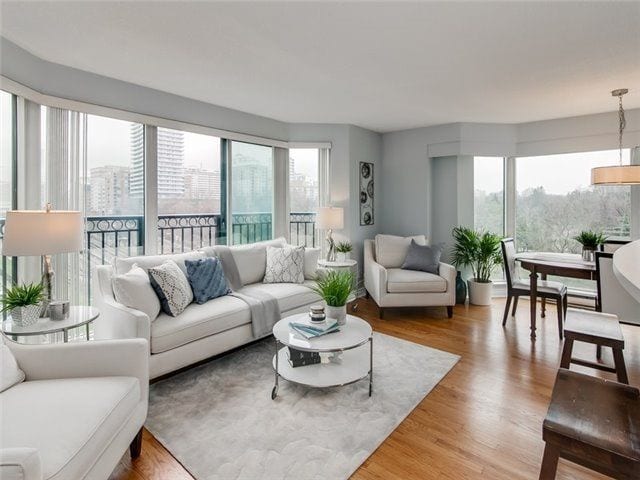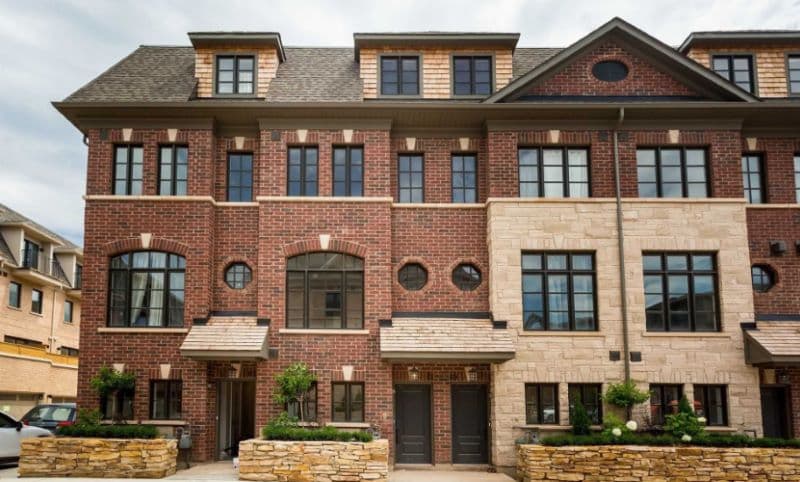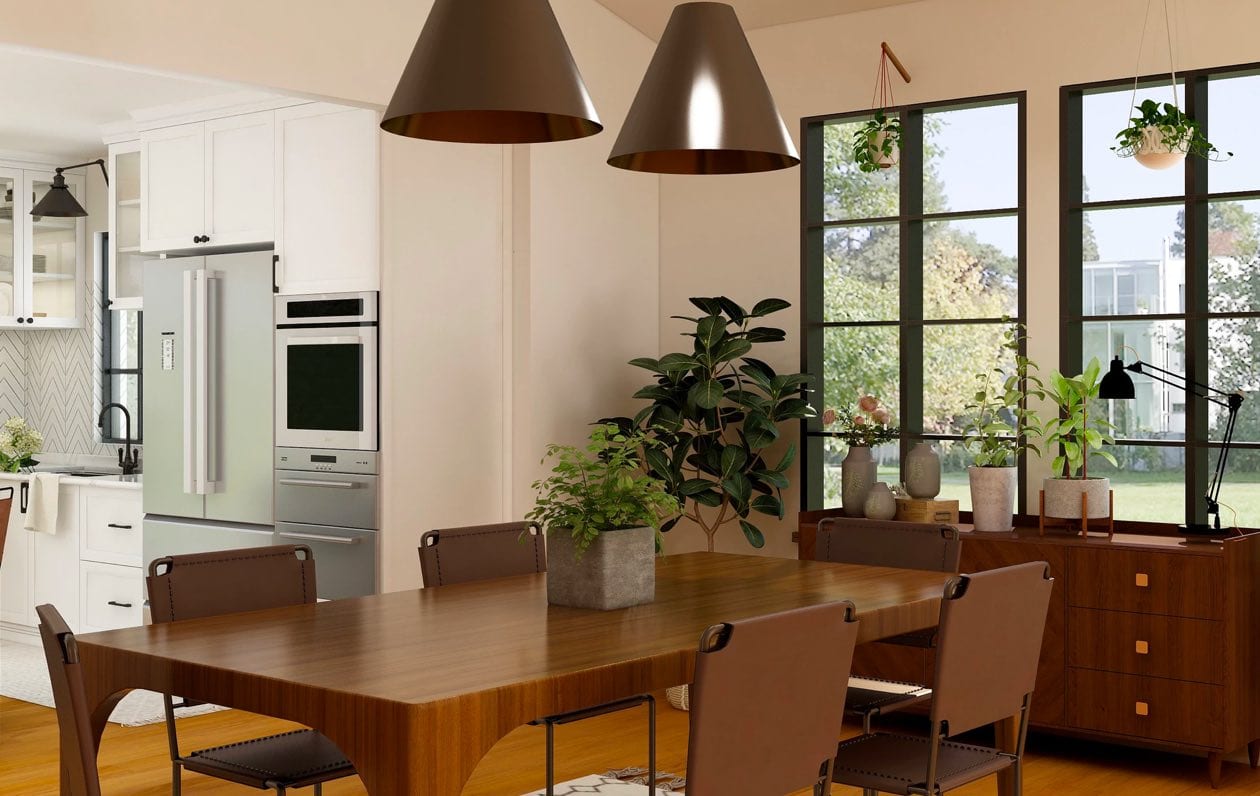
10.22.21 / Buying
10 Steps to Buying a House in Toronto: The Ultimate Planning Guide
This comprehensive planning guide to live in The 6ix is an all-in-one resource for buyers like you. You’ll get the best information, pro tips, and helpful links at your fingertips as you plan your next move. In this guide, we’ll help you prepare for the home-buying process by covering the following:
- What to know before buying a house in Toronto
- How to buy a home in Toronto: 10 steps to buying your dream home
- Step 1: Know your financials
- Step 2: Get pre-approved and financially focused
- Step 3: Establish a budget of estimated costs
- Step 4: Find a realtor
- Step 5: Knowing what you want in your home
- Step 6: Shopping for your home
- Step 7: Making an offer
- Step 8: Getting ready to call your new home, home
- Step 9: The home stretch
- Step 10: Closing an offer
The best way to avoid surprises is to know what’s ahead of you, so read on to find out.
What to know before buying a house in Toronto

We want you to have the best experience with buying a house in Toronto. And that starts with considering several important factors before you even begin the buying process.
- High cost of living – In 2021, Toronto was named the second most expensive city in Canada to live in. So expect to pay significantly higher prices on most things. Even the cost of your car insurance could rise, as motorists pay some of the highest rates in Ontario. Be sure to check out the most expensive and least expensive car insurance wards by postal code to help you minimize the financial impact.
- Housing options & prices – The GTA is one of the most populous metropolitan areas in Canada. So your housing options will likely skew towards condominiums over single detached homes. As of spring 2021, the average price for a detached house in Toronto was $1.75 million, and the average condo was over $720,000. (These are good figures to use when starting your budget plans.)
- Variety of neighbourhoods – There are over 140 officially recognized neighbourhoods in the City of Toronto (soon to be 158). Examining a map of core Toronto neighbourhoods and their profiles can help you prepare a shortlist of the ones you’re interested in moving into. This will save you (and your realtor) time by only looking at real estate listings relevant to those areas.
- Dense & diverse population – Toronto is the most populous city in Canada, the fourth most populous city in North America, and one of the most multicultural cities in the world. The City of Toronto is committed to equity, diversity, and inclusion as reflected in its motto ‘Diversity: Our Strength’.
- Robust public transportation system – Whether it’s by subway, streetcar, train, or bus, you’ll find Toronto’s public transportation is the best way to get around and navigate the city. This will especially be the case as the city’s urban population continues to grow.
- Always something to do – Toronto’s more than just the CN Tower along the waterfront. It also has intriguing museums, fun festivals, alluring concerts, beautiful gardens, edge-of-your-seat major league sports games, and countless restaurants. There’s always a new experience waiting for you in Toronto (though this means you might need to budget more for entertainment)!
- Safety in the city – The Economist’s Safe Cities Index 2021 ranked Toronto the second-safest city in the world based on various areas of security (such as digital, health, infrastructure, personal, and environmental). It’s comforting news, given the city’s dense population.
How to buy a home in Toronto: 10 steps to buying your dream home

Buying a home can be a daunting and stressful process, especially if you are unprepared and don’t know what to expect. That’s why we’ve tried to demystify the process for you so you know exactly what you’re getting into. In this section, we’ve covered everything right from understanding your finances to getting your house keys.
Step 1: Know your financials
It’s important to have a clear understanding of your finances before you start looking for a home. This will put you in a better position to balance your wants and needs, while ensuring you make good decisions for your financial health. This is the most important area to begin with because it will be the key factor that drives all your decisions to come. There’s a lot to consider when looking at your finances to see if you’re ready to start the process of buying a house in Toronto. It’s one of the biggest investments you’ll make (if not the biggest), and there are a number of factors that can determine if now is the right time to buy:
- Income – Do you have a regular, stable income you can count on to help you qualify (and pay) for a mortgage?
- Career stage – Are you at a point where you’re ready to settle down at the same address for five to seven years? If you’re thinking of moving out of the area or overseas in a year or two to pursue career opportunities, it may not be worth your time and money to lock into a mortgage investment.
- Down payment – How much money have you saved that can be used as a down payment? Here’s a closer look at the minimum down payment requirements you can expect:
| Purchase Price | Minimum Down Payment |
| $500,000 or less | 5% |
| $500,000 to $999,9999 | 5% of the first $500,000 +
10% of the portion above $500,000 |
| $1 million+ | 20% |
Your down payment can also be affected by the type of property you’re purchasing, its price, and the lender’s requirements (e.g. if you’re self-employed or have poor credit, they may ask for more than the minimum).
- Existing debt – Do you have a lot of debt to repay? Is it a high percentage compared to what you currently have in assets, investments, and savings?
- Credit score – If your credit score is high, it could result in a better interest rate for your mortgage. But, if it’s low, it could be detrimental to the amount you’re pre-approved for. If you’re not sure what your credit score is, there are a variety of tools available to perform soft inquiries (which will not affect your credit score by running it). What is a good credit score in Ontario? Scores between 660 and 724 are considered good, 725 to 759 are very good, and 760 and up are excellent. These are only guidelines, of course, because there is no specific number that will guarantee you better rates or terms.
- Level of affordability – The Toronto housing market has seasonal highs and lows. So your best bet is to speak with a real estate agent who has a pulse on the local market and can guide you accordingly.
PRO TIPS
✔ Pay off as much debt as you can before starting the buying process.
✔ Maintain good credit by always making your payments on time.
✔ Don’t buy anything expensive until after your house deal closes.
Step 2: Get pre-approved and financially focused

Two questions you should always ask during the home-buying process are “How much can I afford to spend?” followed by “How much debt can I afford to take on?” Your lender will help you answer these questions as you go through the mortgage pre-approval process.
What are the benefits of a pre-approved mortgage?
A mortgage pre-approval is an important step in the home-buying process. Getting pre-approved has several benefits:
- You know exactly how much you can afford, based on what your lender will give you
- You save time by only looking at real estate listings relevant to your price range
- You can immediately put in an offer on a home, so you don’t miss your chance to bid
- You have the ability to act quickly (which is key in Toronto’s competitive market)
- You eliminate the risk and uncertainty of financing (i.e. there’s less chance of a deal falling through for you or the seller)
- You may have some bargaining power, because the pre-approved amount might motivate the seller to negotiate if it’s likely the sale will happen
Key factors your lender might consider for your pre-approval
There are several factors your lender might take into consideration for your pre-approval. These are your income (consistent amounts received regularly), how much you owe (your income-to-debt ratio), and your credit score (your track record for repaying debt).
To see if you qualify for a mortgage and the amount you’d be pre-approved for, the lender will need you to complete and sign a mortgage application. They may also require you to provide some supporting financial documentation.
Since each lender has different proof requirements, it’s best to organize as much as you can in advance. This helps you expedite the approval process by being prepared for whatever they request. Here’s a checklist of documents you might need to submit for your pre-approval.
How do you decide on a lender/mortgage provider?
Like any large investment, you’ll want to research who can give you the best terms, interest rate, and value for the amount you’re going to finance. You could consider going to a mortgage broker, your bank, or other lenders. Here’s what you need to know about each of those options:
- A mortgage broker – Using a mortgage broker has several advantages. They might have access to special rates, and could save you thousands on interest. They are also extremely knowledgeable, and can give you unbiased advice based on your needs because they don’t work for a single lender. This could save you a lot of time and money!
- Your bank – Your bank may offer you a more competitive interest rate if you have a good relationship with them, are a long-time customer, and/or have several investments and savings accounts with them. This is because they will want you to grow your business with them.
- Other lenders – Talk with your friends and family about their mortgage experiences, and you may uncover some lenders you might never have considered before.
If you have coverage with an insurance company that also offers lending services (e.g. Canada Life; formerly London Life), it could lead to a lower interest rate if you add a mortgage to your portfolio with them.
Once you’re pre-approved, you’ll receive a letter from the lender outlining the terms of your mortgage offer. These will include an interest rate guarantee for a set period of time.
PRO TIPS
✔ Since most pre-approved mortgages expire within 90 to 120 days, you’ll want to start shopping right away. You don’t want to run out of time in case it takes longer than expected to find the house you love.
✔ To find a mortgage broker with added credibility and proficiency, look for an AMP (Accredited Mortgage Professional) designation. Your real estate agent can also help you find someone trustworthy whom they’ve worked with before.
Step 3: Establish a budget of estimated costs

To ensure your budget portrays an accurate picture of what everything will cost, you’ll want to include all the financial requirements to buy a house in Toronto. Those go beyond just the purchase price and down payment, and may include:
- Deposit: Within 24 hours of your offer being accepted, you will need to send a certified cheque to the seller’s agent. The amount is usually 5% or more of the purchase price.
- Real estate lawyer fees: The real estate lawyer takes care of reviewing the purchase agreement, arranging for title insurance, registering your mortgage, and all the other details necessary to complete the transaction. The attorney fees typically range from $700 to $2,000.
- Ontario land transfer tax: This fee occurs when a home and property purchase closes and goes to the province. The transfer fee ranges from 0.5 to 2.5% of the purchase price.
- Toronto land transfer tax: This tax is calculated when a home and property purchase closes in specific areas of Toronto. These include south of Steeles Avenue, east of Etobicoke, west of Scarborough, and north of Lake Ontario. The transfer fee ranges from 0.5 to 2.5% of the purchase price.
- Home inspection: A professional home inspector will examine the home you’re interested in buying. They will conduct a thorough inspection of the property (both inside and out), and provide you with a comprehensive report. The home inspection cost ranges from $500 to $1,000+, depending on the size of the property.
- Land survey fee: Before approving your mortgage, your lender may request a current survey or certificate of the property. If a new survey needs to be done, this can be a substantial expense ranging from $1500 to $2500!
- Mortgage default insurance: If you can’t afford a 20% down payment based on the purchase price of the house you were contemplating, any loan you get will be considered high ratio (i.e. high loan to home value). That means it will require mortgage default insurance through the Canadian Mortgage and Housing Corporation (CMHC).
- Home insurance: You will need to arrange residential property insurance to cover the replacement value of the new house and its contents. This will be needed from the day you take ownership, and your lender will require proof of it. This cost can range from $700$ to $2000+ annually.
Other than the costs mentioned above, you might also want to budget for other additional expenses. These could include appraisal fees, mortgage broker fees, and mortgage protection insurance.
PRO TIPS
✔ Just because you’re pre-approved for a certain loan amount doesn’t mean you have to spend all of it.
✔ Balance your budget to meet ALL your goals (owning your home, taking an annual vacation, saving for retirement or education, etc.).
✔ Don’t put yourself in a position where you have a house, but no money to furnish, upgrade or take care of it.
Step 4: Find a realtor

While you’re in the process of getting your pre-approval, you can also start looking for a realtor. This will help you to be ready to start house-hunting as soon as your financing comes through.
To get started, chat with your family and friends about any experiences they’ve had with agents, or anyone they’d recommend. Knowing who good realtors are is just as important as knowing who to avoid.
Next, make a short list of agents you’d like to interview, either from referrals or online research you’ve done yourself. Reach out to them to see if their personality matches your wants/needs, and if you ‘click’ with them.
Here are some questions to ask your realtor:
- Do you actively work in this neighbourhood?
- Do you have a network of sellers in the area that I am looking in?
- How do you plan on adding value to my real estate search?
- How have you helped a past client make a smart real estate or financial decision?
Here are a few key qualifications to look for in an agent:
- Outstanding local market knowledge: Choose a realtor who is familiar with TO neighborhoods, and specializes in the type of home you are looking to buy.
- Good reviews or testimonials: Make sure they have a proven track record and repeat clients. Conducting an Internet search of your realtor’s name is a great way to find this information, along with other insights about them.
- Excellent financial knowledge: They must be able to crunch numbers to give you a good understanding of your options and their financial impacts.
- Great communication & client service skills: They should understand your housing goals, and communicate in a way you understand and feel comfortable. One of their top priorities should be excellent client service that’s demonstrated through responsiveness, showing up on time, and being prepared.
- Network connections: Effective and successful realtors rely on their relationships, so they should have a good reputation in the industry for working well with other agents. This will help them better support your search (and possible negotiations) for a home.
Buying a house in Toronto can be challenging, intimidating, and time-consuming. So it’s important to find a realtor you feel comfortable working with. You need an attentive partner you can trust and rely on for the process you’re about to endure ahead!
Step 5: Knowing what you want in your home

Now that you have your finances and budget, a pre-approved mortgage, and a great real estate agent together, it’s time to get ready to shop!
To help your real estate agent match your needs to available listings, you should:
Create a checklist of ‘must-haves’ for your new home
- Is your family growing, getting smaller, or staying the same?
- How long do you plan on living in this property?
- Are you looking for a detached home, row/townhouse, or condo?
- How many storeys and square feet? How many bedrooms and bathrooms?
- Do you need a room for a home office?
- Do you want an open concept, finished basement, or front/back yard?
- What size of garage? How many parking spaces? Do you need a condo locker?
- Do you want to be near a green space (to walk your pet), a school zone, daycare facilities, public transportation, markets, restaurants, waterfront, local shops or big-box retailers?
Create a list of ‘nice to haves’
- Would you love to have a pool, jacuzzi, or smart home capabilities?
- What about a master bedroom with an ensuite bathroom?
- How about a kitchen island/breakfast bar and main floor (or in-unit) laundry?
- Would granite or marble kitchen counters (with a farm-style, dual, or triple sink), plus a wine fridge, make you happy?
Create a list of ‘deal breakers’
- You don’t want to be close to busy main streets
- You’re not interested if the house needs multiple and/or expensive renovations
- You don’t want anything noisy near train tracks or an airport
Create a prioritized list of neighbourhoods
- Review the demographic profiles of core Toronto areas; this will help you build a list
- Talk with friends/family who live in Toronto and your real estate agent to learn about locations you might not have considered before
- If you don’t have the budget to purchase a house in downtown Toronto, one in an ‘up and coming’ outlying neighbourhood may offer better value now with a higher return over time
- If you’re interested in condo living, certain neighbourhoods have started showing higher condo appreciation rates than others
PRO TIPS
✔ Defining your wants/needs ahead of shopping for a home will ensure your agent can find you the perfect one to suit your lifestyle.
✔ To save time and create an easy purchase path, connect your agent with your lender so they can freely communicate and collaborate.
Step 6: Shopping for your home

This is what you’ve been waiting for! The excitement of finding the new address you will call home. This next set of steps to buying a house in Toronto includes:
- Browse listings from your realtor
Review all the listings your agent sends you, and try not to judge a book by its cover. If the listings you’re receiving are not meeting your expectations, or if some of your criteria have changed, let your agent know immediately. They will modify the property lists they’re sending you. Also, bookmark the online listings you’re interested in so you can easily refer back to them later.
- Schedule a showing or visit an open house
If there’s a property you wish to view, let your agent know the dates and times you’re available to do so immediately. This will help them make an appointment for you as soon as possible. It’s important to move quickly on a listing you’re interested in, because the Toronto market is very competitive due to lack of inventory. In addition, ALWAYS schedule to visit houses alongside your real estate agent. They are the best representative and advocate for YOUR needs with the seller’s agent.
To get a sense of how many potential buyers have been through a home, look at the number of business cards that have been left behind by agents when you arrive at a showing.
Also, remember that your agent is professionally trained to assess what houses are worth based on their condition. So they will be able to bring any areas of concern to your attention while you’re touring. This will help you align your offer accordingly, should you wish to make one.
- Take notes
Bring a notebook to property viewings, and include your “must-haves” checklist in it for reference. Take notes about everything you liked and disliked (after touring 10 or 20 properties, you’ll be thankful you did!).
Also, if you are given permission beforehand (and it’s good etiquette to ask), take plenty of pictures so you have visual cues for things you liked or didn’t.
Provide your agent with ANY positive and/or negative feedback regarding your visits, as it can be very helpful in their search to find exactly what you’re looking for.
Step 7: Making an offer
So you’ve finally found a home you’re excited about and are ready to make an offer. This is where your agent’s knowledge of the market, your competition, and the fair property value within the neighbourhood comes into play. Work with your agent to develop a strategy to balance getting the most from your offer and the best chance of it being accepted.
Given Toronto’s fiercely-competitive real estate landscape and ‘seller’s market’, you may have to go in with a condition-free offer.
Again, your agent can provide guidance on just how much you’ll have to give for a seat at the bargaining table.
Before you make an offer, you may wish to request copies of the water and hydro bills to get a general idea of what to expect for monthly utility expenses.
The process of making an offer begins with your agent preparing an Agreement of Purchase and Sale (APS). This is a legally binding document that includes the following:
- The purchase price you’re offering
- The amount of your deposit
- Your desired closing date (i.e. when you would like to take possession of the home)
- Any inclusions you would like (e.g. TV, water filter system, appliances)
- Any conditions before the deal can go through (e.g. home inspection, financing conditions)
- Your signature on the offer, and any additional documents
Once your APS is complete, it will likely be submitted through an offer presentation (as opposed to a non-offer presentation) to the seller. This has become the new normal in Toronto, given the competitive landscape of high housing demand and low available inventory. The trick is for your agent to know exactly how to navigate these situations with less stress while still achieving your ultimate goal! Here’s what you need to know about these two types of presentations.
Offer presentation

An offer presentation occurs when a seller sets a date and time by which all purchase offers on their house must be submitted. This strategy is very beneficial to the seller because all offers are considered at once, rather than trickling in over a few days. This boosts competition for the sale, and typically generates a higher selling price. It also saves time for the seller and listing agent because by assessing the options simultaneously, they know they’re not settling for one offer when a better one could still be coming.
Once all the offers have been submitted, the listing agent may decide to review them by email. They may also (or instead) invite your agent to an in-person presentation of the APS on your behalf. This meeting can occur anytime at the property address or real estate brokerage, and may include the seller(s) and their lawyer(s) or family.
An offer presentation is your agent’s chance to establish a rapport with the listing realtor and seller. At the same time, they can ‘pitch’ your offer to successfully position it over others. They will emphasize the points of your offer (such as price, closing date, deposit amount, conditions, and other details) to maximize your competitive leverage.
Non-offer presentation
Non-offer presentations are part of how real estate is traditionally sold. When a property comes onto the market and meets your needs, you submit an offer and then negotiate with the seller. Although this seems easier and less stressful than competing in an offer presentation, you need to ensure your realtor is providing you with the proper market information so you can avoid overpaying. Most sellers in this situation will list the home for more than it is worth to try to get the best price possible. This is when your agent should complete a CMA (comparative market analysis) so you can determine a fair value for the house before you begin negotiations. This will go a long way towards helping you end up at a price point you’re happy with.
Once your offer has been made through an offer or non-offer presentation, the seller can reject it, accept it, or come back with a counteroffer. If there’re back-and-forth negotiations, the process can sometimes be stressful, overwhelming, and frustrating. A great agent will help you focus on the numbers (rather than emotions), add perspective, and guide you through small compromises to get what you want.
PRO TIPS
✔ Be ready to lose one, two, or a few offers. No matter how long a property has been on the market, it will usually receive multiple offers.
✔ Remember, “It’s not over until it’s over.” You might lose out on a house, only to find out the winning deal fell through and the property is available again.
Step 8: Getting ready to call your new home, home
Your offer has been accepted! Congratulations! Now what?
- Send the deposit within 24 hours to the seller’s agent.
- Arrange for a home inspection with a reputable and thorough service provider. When you receive the home inspection report, be sure to review the disclosures with your agent. If work needs to be done on the property, strategize with your agent to submit a request for repairs.
- If you’re going to make any additions or construction to the property (such as adding a pool or a guest house), check with the city’s building department to ensure the zoning allows for the upgrades.
- Create a list of renovations you’d like to do once you take possession of the house. Also start budgeting for renovation costs and looking for companies to help you do the actual work.
- Provide your realtor with the contact information for your lawyer and lender so they can get these two people everything they need to finish the deal.
- Make arrangements for homeowner insurance. If you have residential property insurance for your current home, contact your insurance broker or provider to request an estimate for a policy based on your new address. Also, discuss any coverage changes or other needs you require. If you have auto insurance but no home insurance, reach out to your provider to see if they offer residential property coverage and discounts for bundling your home and auto insurance together under one policy. If you’re not sure who to contact for home insurance, ask your family, friends, loan provider, or real estate agent for referrals. You may even be able to take advantage of additional home insurance discounts offered through your post-secondary alumni association, union, or CAA membership.
- Coordinate your change of address, set up utilities, find out when garbage day is, book movers and cleaners, and pay any required deposits.
Step 9: The home stretch

Now it’s time to finalize financing with your lender. The lender will order an appraisal on the home to verify that the market value supports the purchase price.
When you receive the final mortgage agreement for sign-off, double-check that your interest rates, payment amount, payment frequency, and other terms you agreed upon with your lender match the loan arrangements outlined in your pre-approval letter.
The next step is to do a final walkthrough of the home. This is an important step, as it allows you and your agent to double-check that it’s in the condition the seller promised to leave it in. You can also make sure that everything you agreed upon in your offer is present in the house.
You’ll also need to ensure any repairs agreed upon in the transaction were completed. If the improvements are difficult to visually inspect, call back your home inspector or a specialist to ensure they were completed correctly.
PRO TIPS
✔ Turn on all lights, exhaust fans, and appliances to make sure they still work
✔ Open and close doors (including the garage), and inspect ceilings, walls, and floors
✔ Flush toilets, check for leaks under sinks, make sure you have running water, and test the heating/cooling
Step 10: Closing an offer

To close the deal, you will meet with your lawyer to review and sign the final legal documents. Be sure to bring along identification and any additional payment you may need to provide. Once all the financial and legal requirements have been met, possession and ownership transfer from the seller to you, and the house is yours!
The lawyer will give you copies of the final paperwork for your records. Be sure to keep them in a safe place for future reference.
Move in and celebrate!
You made it! All that’s left is to meet up with your real estate agent to get the keys to your new home, and then start your move-in process (and celebrate that you now own a new home)!
Once you take possession of the house, be sure to do the following:
- Change the locks to ensure you’re the only one who has keys
- Change the alarm code (if applicable)
- Change the garage access keypad code (if applicable)
- Forward the mail from your old address to your new one
- Call those who are still sending mail to your old address and ask them to update their records
- Change your address on all your identification cards and other areas it’s used
Moving is a lot of work, so use helpful checklists to keep you on track and organized from 8 weeks in advance of the move to two weeks post-move. They will be sure to make your transition easier and less stressful.
Ready to get started with the process of buying a house?
Make your next purchase the best one you’ve ever made by choosing a great realtor! Any agent with a set of keys can open a door for you; it’s the exceptional client experience and expertise you receive that makes all the difference.
As an industry leader, Matthew Gravina Real Estate does not operate with a “one size fits all” mentality. Every person and every home is different. We take the time to get to know you, so we can custom-tailor a buying strategy that will deliver the results you’re looking for.
Your dream home could already be on the market. It’s time to go find it!
Call Matthew today at 416.805.2763 to get started!



